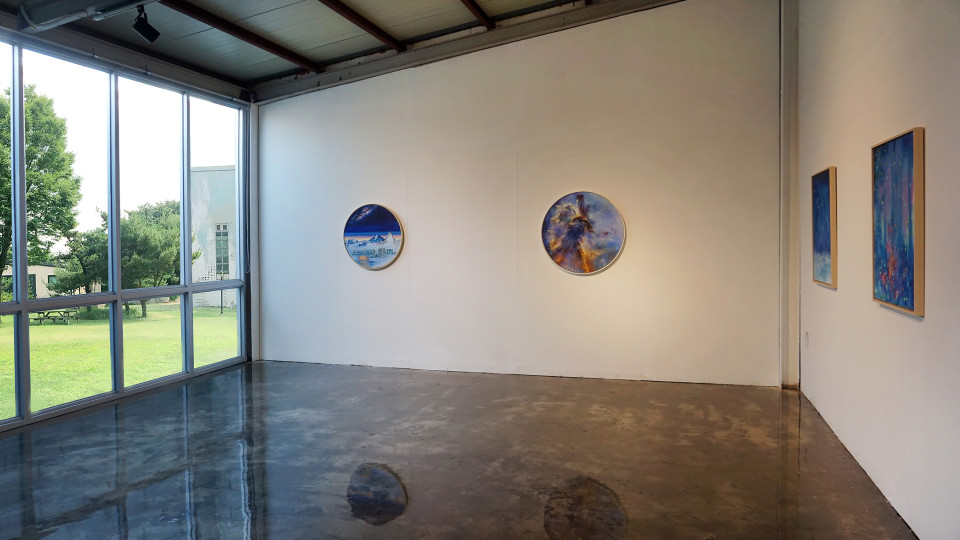April 14 – 18, 2021
2021년 4월 14일 – 18일
link to show: https://cicamuseum.com/anne-wolk-solo-exhibition/
3-A Gallery, CICA Museum
Solo Show — Questions for heaven
link to homepage: https://annewoelk.com/2021/04/12/solo-show-questions-for-heaven-at-cica-museum/
How many stars are there in the Milky Way? If you look at the white band in the night sky with a telescope, you can see that it consists of countless stars. Astronomers have calculated that there are between 100 and 200 billion stars. However, nobody can give a more precise number because the Milky Way is huge. From the earth, the Milky Way appears like a milky brushstroke over the firmament. When looking at the blue night sky every evening, Berlin painter Anne Wölk asks herself many questions. The universe is reluctant to reveal deeper insights into its nature, but with excessive and collective research across nations and disciplines, a diverse understanding can be gained.
For many years, Wölk has been fascinated by science fiction stories about space travel and cyberspace. Involved in the society of digital culture, the artist alters film stills, as well as photographs from the Hubble Space Telescope, and integrates them into her motifs and personal cosmos paintings. During her childhood, Wölk saw an infinite number of simulations of stellar skies and demonstrations of planetary runs at 360-degree shows at the planetarium in her hometown Jena. Jena was the centre for laser and optics technology in the former GDR. This formative experience continually influenced her interest in space travel.
In her solo exhibition at the CICA Museum, Wölk will present her artwork series Planet Spheres and Starscapes.
The idea behind the painted celestial globes originates from astronomical research on exoplanets, which is driven by the search for extrasolar worlds. As a child, Wölk saw night skies’ simulations and detailed presentations of gas planets such as Saturn and Jupiter at the planetarium. Her sky landscapes are painted on spheres of different sizes and hang freely from the ceiling. The three-dimensional paintings are characterised by the use of a slow, precise working method and are made with acrylic paint on styrofoam. The objects embody a fictional and poetic interpretation of possible extraterrestrial worlds, carrying the ideal of romanticism. The starting point for the spheres are astrophotographs from space telescopes. Inspired by viable future colonies on rocky planets, the works refer to the question of whether there is ‘life beyond earth’ and ask, ‘What could colonies look like on other worlds?’
Anne Wölk works in the tradition of the contemporary artists Vija Celmins and Russel Crotty, but she also feels a strong commitment to the Dutch Baroque painter Aert van der Neer, whose speciality was landscapes in winter and at night. Like the old master, Wölk succeeds in painting the facets of light with a sure eye. Her paintings show the glow of the stars in the nightly darkness as a moment of calm. Her wintry scenes convince with the painterly ability to tell a variety of shades of blue in the smallest nuances and to merge them with the vaporwave aesthetics of the early 2010s art movement.
Dreamlike artificial light is floating in the picture space and leads into the emptiness of a virtual vacuum. Starry night skies, modified by photoshop filters, are in contrast to a rainbow colour scale.
Besides, Wölk’s nocturnal landscapes combine pop-sci-fi visual references, such as space stations or LED light beams. Her exclusive conceptional use of enlighted colours is what makes her artwork very contemporary. By creating space with flowing colour gradients and sampling methods, the artist tries to reclose photographic aberrations, digital information gaps, and compression artefacts caused by the technical limitations of telescopic observations and mechanical photography.
The Starscapes series comprises night landscapes with fascinating and mysterious light atmospheres. The motifs came from the tradition of landscape painting of the 17th century when Dutch painters examined night light phenomena in many ways. Although Anne Wölk takes on the precision and painterly compactness of the old masters, she uses film stills from popular science fiction movies as a contemporary template. The painter lets mountain landscapes shine brightly against dark starry skies and magically draws the viewer’s gaze into their depths. A digital glow effect in the horizon line references the excessive screen light of the present day. The classic deep light of traditional oil painting is distorted and expanded by an LED light. The dark shade ‘indanthrene blue’ is omnipresent in the artist’s firmaments. The deep, wide night blue of the sky envelops and quietly warms the viewer in an artistic embrace.

